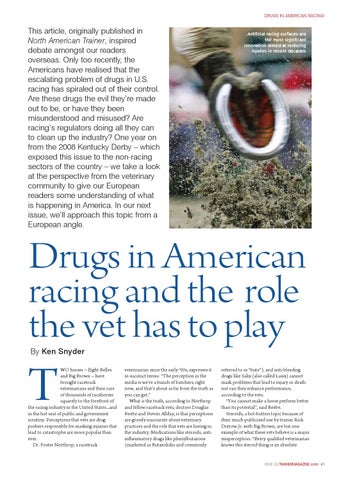VETS EURO.qxd:Jerkins feature.qxd
22/5/09
11:36
Page 1
DRUGS IN AMERICAN RACING
This article, originally published in North American Trainer, inspired debate amongst our readers overseas. Only too recently, the Americans have realised that the escalating problem of drugs in U.S. racing has spiraled out of their control. Are these drugs the evil they’re made out to be, or have they been misunderstood and misused? Are racing’s regulators doing all they can to clean up the industry? One year on from the 2008 Kentucky Derby – which exposed this issue to the non-racing sectors of the country – we take a look at the perspective from the veterinary community to give our European readers some understanding of what is happening in America. In our next issue, we’ll approach this topic from a European angle.
Artificial racing surfaces are the most significant innovation aimed at reducing injuries in recent decades
Drugs in American racing and the role the vet has to play By Ken Snyder
T
WO horses – Eight Belles and Big Brown – have brought racetrack veterinarians and their care of thousands of racehorses squarely to the forefront of the racing industry in the United States...and in the hot seat of public and government scrutiny. Perceptions that vets are drug pushers responsible for masking injuries that lead to catastrophe are more popular than ever. Dr. Foster Northrop, a racetrack
veterinarian since the early ’90s, expresses it in succinct terms: “The perception in the media is we’re a bunch of butchers, right now, and that’s about as far from the truth as you can get.” What is the truth, according to Northrop and fellow racetrack vets, doctors Douglas Beebe and Steven Allday, is that perceptions are grossly inaccurate about veterinary practices and the role that vets are having in the industry. Medications like steroids, antiinflammatory drugs like phenylbutazone (marketed as Butazolidin and commonly
referred to as “bute”), and anti-bleeding drugs like Salix (also called Lasix) cannot mask problems that lead to injury or death nor can they enhance performance, according to the vets. “You cannot make a horse perform better than its potential”, said Beebe. Steroids, a hot-button topic because of their much-publicised use by trainer Rick Dutrow Jr. with Big Brown, are but one example of what these vets believe is a major misperception. “Every qualified veterinarian knows this steroid thing is an absolute
ISSUE 26 TRAINERMAGAZINE.com 41
